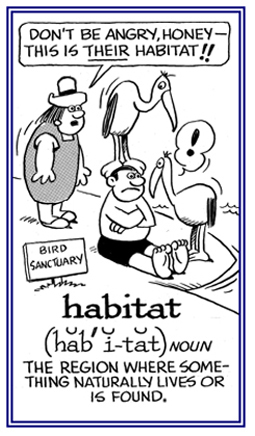You searched for:
“habitat”
1. The specific, natural environment and living conditions for animals or plant species: The Western plains were the habitats of the buffalo.
2. The living space, dwelling, or context in which an individual or group lives: The hermit's habitat was a crude cabin in the forest.

© ALL rights are reserved.

© ALL rights are reserved.
Go to this Word A Day Revisited Index
2. The living space, dwelling, or context in which an individual or group lives: The hermit's habitat was a crude cabin in the forest.


Go to this Word A Day Revisited Index
so you can see more of Mickey Bach's cartoons.
This entry is located in the following unit:
habit-, hab-, -hibit; habili-, habil-
(page 3)

A unit related to:
“habitat”
(Greek: house, household affairs [environment, habitat], home, dwelling; used in one extensive sense as, "environment")
(acknowledgements of information utilized for -cola, -colas; -cole; -colent; -colid; -coline; -colous word entries)
(from the depths of the ocean floors to the highest mountains, from dry deserts to grasslands, and the warm and wet tropical areas; all provide each form of life its preferred habitat)
Word Entries containing the term:
“habitat”
Forest trees that thrive in areas where very few other species of trees can survive in cold and in mountain ranges: "The coniferous-forest habitats include redwoods, spruces, and firs."
"Coniferous trees produce cones and don't lose their needle-leaves in the winter and such habitats support a diversity of animal and other plants."
This entry is located in the following unit:
Habitats for the Living
(page 1)
Considered to be the "rain forests" of ocean life because of the great varieties of species that are supported there: "The coral-reef habitats have come into existence as a result of the skeletons of many marine organisms in the shallow, sunlit tropical waters."
This entry is located in the following unit:
Habitats for the Living
(page 1)
An excessive lack of rain and soils restrict the growth of plants: "Desert habitats have been created because they don't have the means to sustain much in the way of resources for biodiversity."
"It is estimated that approximately one-third of the Earth's land areas consist of desert habitats."
"The earth's largest desert habitat is the African Sahara."
This entry is located in the following unit:
Habitats for the Living
(page 1)
A living space that is dominated by grasses and similar vegetation, typically fairly flat and may be inhabited by large and small animals: "Some temperate grassland habitats are without trees but most of them have very fertile soils."
"Savanna grassland habitats often are more like open woodland with some trees scattered in small groups and woody plants much smaller than trees."
This entry is located in the following unit:
Habitats for the Living
(page 1)
Living spaces for plants and animals as part of high places which rise as high as five and a half miles (nine kilometers) above sea level and have several different environments: "Each height can have several mountain habitats from temperate woodland on up to arctic conditions as climate changes take place when going up to higher altitudes."
This entry is located in the following unit:
Habitats for the Living
(page 1)
A place where ecosystems are found at all levels, from the sunlit surface areas down to the deepest existence of life under water: "The ocean habitats cover about two-thirds of the Earth and support many kinds of life forms from the microscopic planktons to the blue whale, which is the biggest living mammal."
This entry is located in the following unit:
Habitats for the Living
(page 1)
Geographical areas that are dominated by great amounts of snow and ice and also consist of vast, dry areas of polar desert because of very small amounts of rainfall: "The polar-region habitats include the Arctic and Antarctic zones with 24-hour periods of daylight in the summer and continuous darkness in the winter."
"Both polar regions provide animal life; including fish and other sea life for the polar bears, seals, penguins, etc."
This entry is located in the following unit:
Habitats for the Living
(page 1)
Various areas that are saturated with water; either seasonally or permanently and that consist of landscapes that have dense vegetation: "River and wetland habitats have a significant variety and quantity of animals and plants living in them."
This entry is located in the following unit:
Habitats for the Living
(page 1)
An environment that is between the tropics and the polar areas which are not subject to extreme temperatures: "The conditions of the temperate-forest habitats are determined by both the tropical and the polar air masses which provide a great deal of biodiversity."
"The extent of the temperate-forest habitats has been considerably diminished by people as they cut down so many trees."
This entry is located in the following unit:
Habitats for the Living
(page 1)
